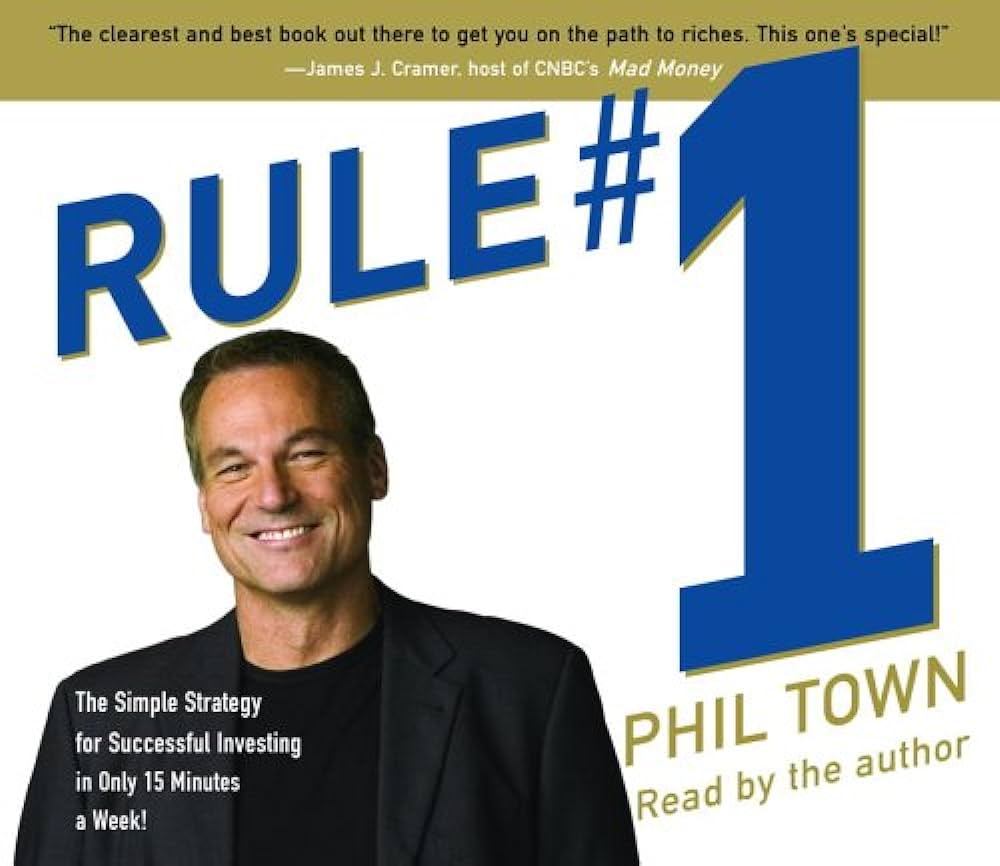
Rule #1 : The Simple Strategy for Successful Investing in Only 15 Minutes a Week! เป็นหนังสือที่เขียนโดย Phil Town เป็นหนังสือที่ให้แง่มุมอีกด้านเกี่ยวกับการลงทุนให้กับเราได้

เงินเป็นปัจจัยสำคัญในการดำเนินชีวิต คงเป็นเรื่องโกหกหากจะพูดว่าเงินซื้อความสุขไม่ได้ จริงอยู่ที่เงินซื้อไม่ได้ทุกอย่างบนโลกใบนี้ แต่เงินก็ซื้อหลายอย่างได้เป็นส่วนใหญ่ จึงเป็นเหตุผลที่เงินกลายเป็นสิ่งที่กระตุ้นมนุษย์ให้ทำดีอย่างสุดขั้วและชั่วอย่างสุดขีดได้เหมือนกัน เพื่อให้ได้ความสุขในแบบที่ตนเองต้องการ
ว่ากันตามจริงแล้วมีหลายวิธีที่จะผลักดันให้ใครสักคนกลายเป็นคนรวย มีความมั่งคั่ง หรือมีเงินทองในมือจำนวนมากตามต้องการได้ หากอ้างอิงจากสิ่งที่เคยได้ยินกันมานั่นก็คือ ต้องขยันเข้าไว้ ต้องตั้งใจเข้าหน่อย เดี๋ยวก็รวยเอง แต่ถ้าเป็นแบบนั้นจริงๆ คนจนคงไม่ล้นประเทศอย่างในทุกวันนี้
“คุณไม่จำเป็นต้องฉลาดขนาดนั้นเพื่อให้ได้เงินมา”
ตั้งใจเรียน เรียนให้เก่งเข้าไว้แล้วจะได้งานดีๆ ซึ่งหมายถึง เงินจำนวนมากใช่ไหม? กระบวนการนี้ก็ไม่ผิด แต่อาจจะไม่ได้ผลกับทุกคน จากหลากหลายวิธีชี้ช่องทางรวย จากหนังสือ Rule #1 Phil Town ได้บอกเล่าถึงอีกหนึ่งวิธีรวย ซึ่งคุณไม่จำเป็นต้องฉลาดไอคิวสูงหรือสอบได้ที่ 1 ของห้อง คุณก็สามารถมีเงินจำนวนมากในกระเป๋าสตางค์ได้เพียงแค่คุณเรียนรู้วิธีการลงทุนด้วย กฎ #1 ของ Phil Town ซึ่งมันคือผลลัพธ์ของกลยุทธ์การลงทุนที่ตอบสนองความต้องการในตลาดเพียงแค่คุณมีคอมพิวเตอร์ คุณก็สามารถเป็นนักลงทุนกฎ #1 ได้แล้ว
“ผลตอบแทนที่มากขึ้นแลกมากับความเสี่ยงที่มากขึ้น”
เกือบทุกคนที่เข้าวงการนักลงทุนหรือกำลังสนใจในการลงทุนอยู่ หนึ่งในสัจธรรมการลงทุนที่ทราบกันดีคือ อัตราผลตอบแทนที่สูงขึ้นนั้นหมายถึงความเสี่ยงที่มากขึ้นด้วยเช่นกัน ทุกคนระแวงและกังวลที่จะสูญเสียเงินจำนวนมากเพื่อแลกกับผลตอบแทนที่สูงกว่า แต่ก็อดที่จะไม่แตะต้องความเสี่ยงที่ยั่วยวนเหล่านั้นไม่ได้ ความจริงก็คือ อัตราผลตอบแทนที่สูงขึ้น ไม่จําเป็นต้องขึ้นอยู่กับการก่อความเสี่ยงมากขึ้นก็ได้ หากคุณยังไม่รู้ทิศทางความต้องการหรือเป้าหมายของสิ่งที่คุณกำลังพยายามทำอยู่ การเดินทางของคุณในเส้นทางการลงทุนอาจจะช้าและอาจจะอันตรายมาก
“ความสำคัญของกฎ #1 คือการรู้ว่าตัวเองกำลังทำอะไร?”
การเป็นนักลงทุนกองทุนรวมมีความเสี่ยงมากกว่าการเป็นนักลงทุนกฎ #1 ยิ่งหากคุณเป็นเจ้าของกองทุนรวมที่พยายามจะเอาชนะตลาดและไว้วางใจผู้จัดการกองทุนของคุณเพื่อให้คุณเกษียณได้อย่างสบายใจแล้วล่ะก็ คุณกำลังเป็นเหยื่อของการหลอกลวงครั้งใหญ่ ผู้จัดการกองทุนส่วนใหญ่ไม่เอาชนะตลาด แม้มันจะเป็นสิ่งที่คุณจ่ายเพื่อจ้างให้พวกเขาทำก็ตาม อย่างน้อยคุณควรรู้ว่าคุณกำลังทำอะไร ไม่ใช่แค่เพียงจ่ายเงินจ้างให้คนอื่นทำเท่านั้น การลงทุนด้วยความมั่นใจในสิ่งที่ทำจะทำให้คุณไม่สูญเสียเงิน
3 ตำนานความเชื่อในการลงทุนที่ถูกส่งต่อกันมาว่าเป็นพื้นฐานหรือหัวใจหลักของการลงทุน ที่จะทำให้คุณไม่เสียเงินไปอย่างเปล่าประโยชน์และไม่รู้สาเหตุของการเสียเงินก้อนอย่างแท้จริงเสียด้วย
1. คุณต้องเป็นผู้เชี่ยวชาญในการจัดการเงิน มันเป็นเรื่องที่ไม่ได้ยากเย็นอะไรเลย ถ้าจะขอเวลาให้กับการศึกษาวิธีการลงทุน ทำความเข้าใจสิ่งที่คุณกำลังทำ หรือพยายามเรียนรู้การจัดการเงินของตัวเองด้วยตัวเองเพียง 15 นาทีต่อสัปดาห์เท่านั้น
2. คุณไม่สามารถเอาชนะตลาดได้ แต่คุณสามารถใช้ประโยชน์จากความผิดพลาดในแต่ละวัน เพื่อเก็บเกี่ยวผลตอบแทน 15% ขึ้นไปได้
3. วิธีที่ดีที่สุดในการลดความเสี่ยงคือ การกระจายความเสี่ยงและการถือครองในระยะยาว คุณซื้อดอลลาร์ในราคาเซ็นต์และขายภายหลังในราคาหนึ่งดอลลาร์ ทำแบบนี้ซ้ำๆ จะรวยมาก
Dollar Cost Averaging (DCA)
เครื่องมือการขายที่ใช้โดยผู้จัดการกองทุนและโบรกเกอร์คือ Dollar Cost Averaging (DCA) ซึ่งเป็นกลยุทธ์ในการซื้อหุ้นหรือกองทุนรวมในแต่ละเดือนด้วยเงินจำนวนเท่ากัน โดยไม่คำนึงถึงราคาหุ้นหรือกองทุนหากราคาลดลงเงินของคุณจะซื้อหุ้นได้มากขึ้น และเงินของคุณจะซื้อหุ้นน้อยลงเมื่อราคาขึ้น
“กฎข้อที่ #1 แท้จริงแล้ว คือ “อย่าเสียเงิน”
แต่ในทางปฏิบัติหมายถึง การลงทุนด้วยความมั่นใจ ซึ่งมาจากการการลงทุนที่ยอดเยี่ยมในราคาที่น่าสนใจ
เป้าหมายของการ Dollar Cost Averaging คือ การจํากัดความเสี่ยงในการลงทุนของคุณโดยทําให้ต้นทุนเฉลี่ยต่อหุ้นแต่ละหุ้นเล็กลง เพื่อให้ DCA ทํางานได้คุณต้องใส่จํานวนเท่ากันทุกเดือนไม่ว่าจะเกิดอะไรขึ้น กฎ #1 เป็นพื้นฐานของการลงทุนที่ยอดเยี่ยมในช่วงร้อยปีที่ผ่านมา และจะเป็นพื้นฐานของการลงทุนที่ยอดเยี่ยมในอีกร้อยปีนับจากนี้
“คุณควรรู้ว่าคุณจะทำเงินได้มากจากการลงทุนที่ยอดเยี่ยมในราคาที่น่าดึงดูด”
คำว่า “ยอดเยี่ยม” สามารถพูดให้เข้าใจง่ายได้โดยครอบคลุม 3 องค์ประกอบด้วยกันคือ ธุรกิจต้องมีความหมายต่อคุณ คุณเข้าใจมันมากพอที่จะต้องการเป็นเจ้าของมัน และถ้าคุณทำได้ ธุรกิจนั้นจะสะท้อนคุณค่าของคุณออกมาด้วย ต่อไปธุรกิจต้องตรงตามเกณฑ์ในแง่ความแข็งแกร่งทางการเงินและสามารถคาดการณ์ได้ และสุดท้ายคุณต้องการการจัดการที่ดี อย่างไรก็ตาม 3 ข้อนี้ อาจจะยังรู้สึกว่าไม่เพียงพอต่อการลงทุน อีกหนึ่งสิ่งที่เพิ่มเติมเข้ามาคือ ธุรกิจนั้นมีราคาที่น่าสนใจ มีอัตรากําไรขั้นต้นด้านความปลอดภัย (MOS – Margin of Safety) ที่ใหญ่มาก และที่สำคัญเลยคือ สิ่งสําคัญคือต้องรู้ว่าราคาของสิ่งนั้นไม่เท่ากับมูลค่าของมันเสมอไป
การลงทุนตามกฎ #1 มี 4 ขั้นตอนดังต่อไปนี้
- ค้นหาธุรกิจที่ยอดเยี่ยม
- รู้ว่าธุรกิจมีค่าแค่ไหน
- ซื้อในราคาลด 50%
- ทําซ้ำจนรวยมาก
“ลองนึกภาพการลงทุนเงินของคุณไปกับการเพาะเมล็ดในดิน คุณจะต้องเก็บเกี่ยวสิ่งที่คุณหว่าน”
ธุรกิจที่ยอดเยี่ยมควรมีผู้ขับเคลื่อนให้บรรลุเป้าหมายที่ยิ่งใหญ่นั้นได้จริงด้วย ในหนังสือของเขา Good to Great ผู้เขียนและนักวิจัยทางธุรกิจ Jim Collins กล่าวว่า CEO ที่ย้ายบริษัท เป็นเพราะพวกเขาก้าวไปสู่ความยิ่งใหญ่ที่เขาเลือก ซึ่งจะเรียกพวกเขาว่าเป็นผู้นำระดับห้า ซึ่งเหล่าผู้นำระดับห้ามักยึดมั่นในการไปสู่เป้าหมายที่ใหญ่กว่าเดิม มีความต้องการสร้างบริษัทที่ยอดเยี่ยม คุณสมบัติของพวกเขาสามารถสรุปได้ว่าเป็นผู้นำที่มุ่งเน้นการเป็นเจ้าของและมีความต้องการขับเคลื่อนธุรกิจ
“CEO ที่มุ่งเน้นการเป็นเจ้าของคือ ผู้ที่มีผลประโยชน์ส่วนตัวโดยตรงกับผู้ถือหุ้นของธุรกิจ”
Bill Gates และ Steven Ballmer ของ Microsoft มองว่าตัวเองเป็นเจ้าของและบริหารบริษัทตามนั้น พวกเขามุ่งเน้นการเป็นเจ้าของที่ดูเหมือนทำราวกับว่าบริษัทเป็นสินทรัพย์เดียวที่ครอบครัวพวกเขาจะถือยาวไปอีก 100 ปีข้างหน้า พวกเขาจะผลักดันให้เกิดการเปลี่ยนแปลงโลกด้วยวิธีเล็กๆ และสงบ แต่กลับสร้างผลกระทบในเชิงบวกได้อย่างมาก เพราะแม้จะเปลี่ยนแปลงเล็กน้อยแต่ทำเป็นประจำและให้ความสำคัญทุกวัน สุดท้ายแล้วการเปลี่ยนแปลงที่พวกเขาต้องการจะสร้างคุณค่าให้กับตัวพวกเขาในขณะที่มันจะกลายเป็นวิสัยทัศน์ของบริษัทนั้นๆอีกด้วย หากเป็นสิ่งที่ดีก็สามารถขับเคลื่อนธุรกิจได้นานหลายปี
บทสรุป
จงจําไว้ว่า…เป้าหมายของคุณคือซื้อ 1 ดอลลาร์สําหรับ 1 เซ็นต์ คุณอาจพบธุรกิจอย่างน้อยหนึ่งธุรกิจที่มีความหมายกับคุณซึ่งคุณจะภูมิใจที่ได้เป็นเจ้าของและคุณจะเข้าใจ คุณควรเริ่มต้นทำการบ้านตอนนี้เลยหากคุณสนใจช่องทางรวยอื่นนอกจากการตั้งใจเรียนแล้วต่อด้วยการตั้งใจทำงานเพื่อก่อร่างสร้างตัว ลองแบ่งเวลาไว้สำหรับการตั้งใจศึกษาการลงทุนดู คุณจะพบว่าธุรกิจมีอยู่มากมายให้คุณค้นพบเพื่อลงทุน
จงจำไว้ว่า…ธุรกิจประเภทเดียวที่มีอนาคตและคาดการณ์ได้คือบริษัทที่ยอดเยี่ยม อย่าขี้เกียจ สิ่งสําคัญที่สุดคืออย่ามองข้ามการเป็นนักลงทุนกฎ #1 ที่แท้จริง ก้าวเข้าสู่สนามเพื่อสร้างรายได้ให้กับตัวเอง ก้าวไปทีละก้าวโดยไม่รีบร้อน ในโลกกว้างแห่งนี้มีบริษัทที่ยอดเยี่ยมในราคาที่น่าสนใจเสมอ อย่าปล่อยให้ความกลัวการสูญเสียบังคับให้คุณให้เงินแก่อุตสาหกรรมบริการทางการเงินต่อไป คุณไม่จําเป็นต้องมีผู้จัดการกองทุน คุณสามารถลงทุนได้สำเร็จด้วยตัวคุณเอง
“กฎ #1 ไม่ได้เหมาะกับคนอายุมากที่ช่ำชองในเรื่องการลงทุน ไอคิวสูง หรือมากด้วยหน้าตาทางสังคม มันเหมาะกับใครก็ตามที่พร้อมจะใช้มันอย่างถูกต้องและไม่ต้องการกังวลเรื่องเงินอีกต่อไป”
บทความแนะนำ:
The 15 Invaluable Laws of Growth – กฎทองแห่งการพัฒนาตนเอง 15 ข้อ







